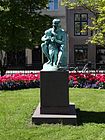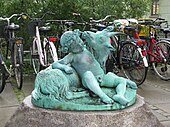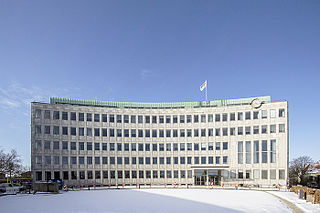
Lyngby-Taarbæk Municipality is a municipality in the Capital Region of Denmark near Copenhagen on the eastern coast of the island of Zealand. It is part of the Greater Copenhagen area. The municipality borders Rudersdal Municipality to the north, Furesø Municipality to the west and Gladsaxe and Gentofte Municipality to the south. It borders the Øresund to the east.

Kongens Lyngby is the seat and commercial centre of Lyngby-Taarbæk Municipality in the northern suburbs of Copenhagen, Denmark. Lyngby Hovedgade is a busy shopping street and the site of a branch of Magasin du Nord as well as Lyngby Storcenter. The district is also home to several major companies, including COWI A/S, Bang & Olufsen, ICEpower a/s and Microsoft. The Technical University of Denmark relocated to Lyngby from central Copenhagen in the 1970s. Lyngby station is located on the Hillerød radial of Copenhagen's S-train network.

Assistens Cemetery in Copenhagen, Denmark, is the burial site of many Danish notables as well as an important greenspace in the Nørrebro district. Inaugurated in 1760, it was originally a burial site for the poor laid out to relieve the crowded graveyards inside the walled city, but during the Golden Age in the first half of the 19th century it became fashionable and many leading figures of the epoch, such as Hans Christian Andersen, Søren Kierkegaard, Christoffer Wilhelm Eckersberg, and Christen Købke are all buried here.

Johan Frederik (Frits) Nikolai Vermehren, also known as Frederik Vermehren, a genre and portrait painter in the realist style.
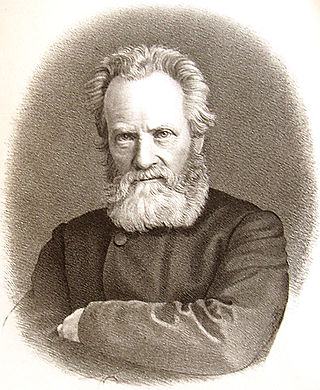
Herman Wilhelm Bissen was a Danish sculptor. Bissen created a number of public works, working in plaster, marble and bronze.

Michael Gottlieb Birckner Bindesbøll was a Danish architect active during the Danish Golden Age in the first half of the 19th century. Most known for his design of Thorvaldsens Museum in Copenhagen, he was a key figure in the stylistic shift in Danish architecture from late classicism to Historicism. He was the father of the designer Thorvald Bindesbøll and the textile artist Johanne Bindesbøll.

Sorgenfri Palace is a royal residence of the Danish monarch, located in Lyngby-Taarbæk Municipality, on the east side of Lyngby Kongevej, in the northern suburbs of Copenhagen. The surrounding neighbourhood is called Sorgenfri after it. Only the cellar and foundations survive of the first Sorgenfri House, which was built in 1705 to design by François Dieussart. The current house was built in 1756 by Lauritz de Thurah and later adapted and extended by Peter Meyn in the 1790s. Lauritz de Thurah has also designed buildings which flank the driveway closer to the road.
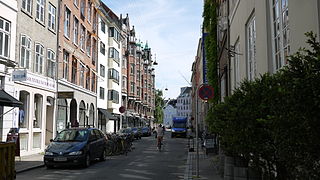
Store Strandstræde is a street in Copenhagen, Denmark. It extends diagonally from Kongens Nytorv, at the corner of Nyhavn and Bredgade, to Sankt Annæ Plads. Lille Strandstræde joins the street shortly before reaching Sankt Annæ Plads.

Christian Gottlieb Vilhelm Bissen was a Danish sculptor. He was also a professor at the Royal Danish Academy of Fine Arts with great influence on the next generation of Danish sculptors and for a while served as its director. Bissen was trained in the Neoclassical tradition from Bertel Thorvaldsen but after a stay in Paris around 1880, he was influenced by Naturalism. With the equestrian statue of Absalon he turned to Neo-romanticism.

Georg Hilker was a Danish decorative painter active during the Danish Golden Age in the first half of the 19th century. He collaborated with painter Constantin Hansen (1804–1880).

Johan Martin Quist or Qvist was a Danish architect who made a significant contribution to the city of Copenhagen. Together with those of Andreas Hallander, his classically styled buildings form part of the legacy of 19th-century Danish Golden Age architects who reconstructed areas of the old town which had been destroyed in the Copenhagen Fire of 1795.

The Trinitatis Church is located in central Copenhagen, Denmark. It is part of the 17th century Trinitatis Complex, which includes the Rundetårn astronomical observatory tower and the Copenhagen University Library, in addition to the church. Built in the time of Christian IV, the church initially served the students of Copenhagen University. It is situated at the corner of Landemærket and Købmagergade. The interior was seriously damaged in the fire of 1728 but was rebuilt in 1731.

Frederik Vilhelm Tvede was a Danish architect.

Ludvig Brandstrup was a Danish sculptor. He is remembered above all for his equestrian statue of Christian IX in Esbjerg but was also one of the most competent portraitists of his day.

Lottenborg is an 18th-century roadside inn located next to Sorgenfri Cemetery in Sorgenfri, Lyngby-Taarbæk Municipality, in the northern suburbs of Copenhagen, Denmark. It is situated on Lottenborgvej, a side street to Lyngby Kongevej located opposite Sorgenfri Palace. The building is still used as a restaurant but is only open for lunch Thursday through Sunday.
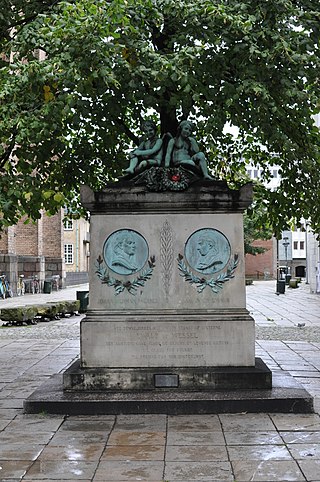
The Johannes Ewald and Johan Hermann Wessel Memorial is located next to the Round Tower and Trinitatis Church, just off Købmagergade, in central Copenhagen, Denmark. Johannes Ewald and Johan Herman Wessel were two of the leading Danish poets of the 18th century.

Lyngby Church is the oldest church in Lyngby-Taarbæk Municipality in the northern suburbs of Copenhagen, Denmark. It is perched on a hill above Lyngby Hovedgade.
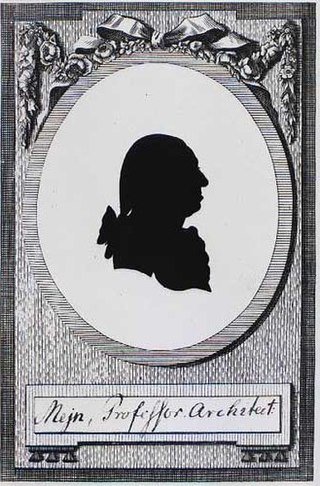
Peter Meyn was a Danish architect.

Siegfried Wagner was a Danish sculptor.

Taarbæk Church, formerly known as Skovkapellet, is a Church of Denmark parish church in Taarbæk, Lyngby-Taarbæk Municipality, some 15 km north of central Copenhagen, Denmark. The church and adjacent cemetery is bordered by Jægersborg Dyrehave to the north and west and by the Coast Line to the east. The church was inaugurated in 1864 but Taarbæk Paris was not disjoined from that of Lyngby until 1907.

